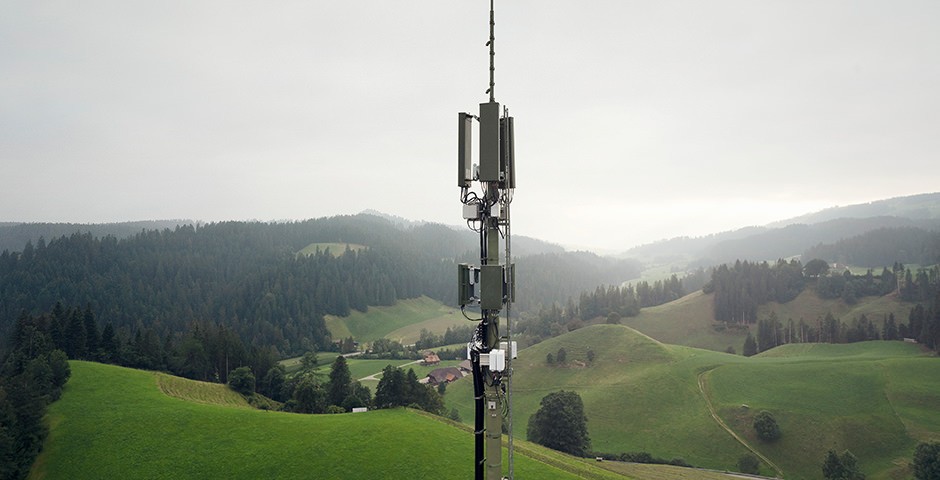
“Exponential growth in data transmission means exponential growth in radiation exposure.”
Mobile telephony critic from the Schutz vor Strahlung association, quoted in the Tages-Anzeiger
In recent years, the volume of data transmitted on mobile networks has doubled every year on average. In other words, it has increased exponentially, as a woman from the Schutz vor Strahlung (Protection Against Radiation) association rightly told the Tages-Anzeiger newspaper.
Each year, the previous year’s volume is added. As a consequence, the volume of data transmitted wirelessly has increased more than 200-fold in the past 15 years. 200 times more data is an enormous increase. However, the rate at which transmission speeds have increased over the same period is even more impressive: Data can currently be transferred about 20,000 times faster than was possible 15 years back. That amazes experts and perplexes laymen. Even annual growth rate of just 1% would correspond to an exponential increase, albeit a less rapid one.
However, the aforementioned mobile telephony critic probably did not mean that. Rather, she assumed that the enormous increase in data must likewise result in a similarly enormous linear growth in radiation exposure. Incidentally, instead of “radiation exposure,” you can also use the expression “exposure to electromagnetism” to discuss the matter in a less frightening manner.
The installation limit remains the red line
We have noted that 5 V/m is the installation limit for the vast majority of mobile antennas located in areas where people spend longer periods of time. That also applies to 5G. Higher values are not permitted in Switzerland, and this is verified on a daily basis. Incidentally, most other countries use the World Health Organisation recommendation of 50 V/m.
If the field intensity of mobile antennas had also increased 200-fold in line with the increase in data, we would have measurable field strengths of 600-1000 V/m today. That would be quite a lot – a worrying amount. And if we had an exponential increase in immissions in line with the massive increase in transmission speeds, we would probably no longer be sitting here.
Field intensities far from reality
Let’s take a look back and continue our calculations: When we only had 2G, in the mid-1990s, the field intensity must therefore have been at an infinitesimally small 20m V/m (thousandths of a volt per metre) or far, far lower, given that data transmission is now 20,000 times faster. According to Adam Riese, the maths simply doesn’t add up. Even back then, antennas came close to the 5 V/m limit. If we extrapolate from the past to today, a field intensity of 3 V/m, for example, would have increased 200-fold or even 20,000-fold. Hmm …. Both are far from reality.
We already calculated the figure further up using a factor of 200. So if we now play through the scenario using the increase in transmission speed (a factor of 20,000), we would currently find ourselves with field intensities at which the dielectric strength of air would already be exceeded at DC voltage and we would be able to observe arcs. That would make a hell of a storm – and undoubtedly precipitate Mankind’s immediate extinction.
Clever coding for low radiation
No! The enormous growth in data can be handled with almost identical immissions as we had 15 years ago because the modulation types (i.e. the way signals are transmitted) have become much more sophisticated. More data can be transmitted per oscillation in Hertz per second because the encoding has become much more precise and terminals such as smartphones or tablets has become much more sensitive. As a result, even significantly weaker signals can still be received well. Last but not least, multipath spread and frequency band aggregation also factor into the equation, which is why much more capacity can now be provided wirelessly at almost constant field intensities. In short, mobile communication technology has improved massively.
The aforementioned mobile telephony critic can therefore rest reassured that the amount of radiation has remained unchanged over the years and her claim is merely a bold hypothesis, which its readers will hopefully realise. Because physics remains physics, no matter how you present it.
Latest news about Swisscom
Subscribe to News
Contact us
Address
Swisscom
Mobile communications and the environment
Alte Tiefenaustrasse 6
3048 Worblaufen
Postal address:
Postfach, CH-3050 Bern
Switzerland
